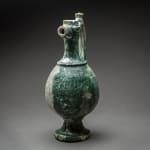Parthian Green-Glazed Zoomorphic Ewer, 4th Century CE - 6th Century CE
Terracotta
height 24.1 cm
height 9 1/2 in
height 9 1/2 in
X.0059
Further images
Terracotta Ewer with spout shaped in the form of a birds head with moulded eyes and beak forming pouring hole; ovoid- shaped body standing upon tall, bell foot; slender, concave-sided...
Terracotta Ewer with spout shaped in the form of a birds head with moulded eyes and beak forming pouring hole; ovoid- shaped body standing upon tall, bell foot; slender, concave-sided neck with prominent moulded flange at base; arched handle surmounted by pomegranate finial; superb, iridescent green-glaze over whole.
When, in 7th century, the Islamic Arab armies overran the major part of the Near East, they discovered several well-established pottery centres, which had seen little change in technical skill and artistic traditions over several millennia. Glazed pottery was invented and introduced in Egypt during the fourth millennium BCE before spreading to Central Asia. The manufacture of these alkaline glazed vessels continued throughout the Sassanian period right up to early Islamic times.
Given to the continuity of shapes, pastes, colours and decoration over the centuries it is difficult to distinguish between pre-Islamic and early Islamic vessels. Though in this case the refinement of the shape and evolution of the zoomorphic spout suggest a later date of manufacture.
When, in 7th century, the Islamic Arab armies overran the major part of the Near East, they discovered several well-established pottery centres, which had seen little change in technical skill and artistic traditions over several millennia. Glazed pottery was invented and introduced in Egypt during the fourth millennium BCE before spreading to Central Asia. The manufacture of these alkaline glazed vessels continued throughout the Sassanian period right up to early Islamic times.
Given to the continuity of shapes, pastes, colours and decoration over the centuries it is difficult to distinguish between pre-Islamic and early Islamic vessels. Though in this case the refinement of the shape and evolution of the zoomorphic spout suggest a later date of manufacture.







